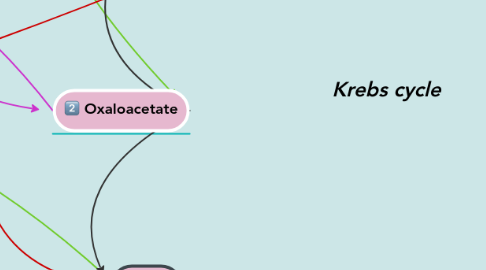Krebs cycle
by Waddaah Tharwat Ahmed


1. Under supervision of Dr.Dalia Ali head of medical biochemistry department
2. Farnesyl-PP
2.1. Squalene
2.1.1. 2,3-Oxidosqualene
2.1.1.1. Lanosterol
2.1.1.1.1. Cholesterol
3. Dimethylallyl-PP
4. Geranyl-PP
5. Geranylgeranyl-PP
6. Tryptphan
7. Glycine
8. Cysteine
9. Serine
10. Fructose 1-phosphate
11. Glycogen
12. UDP-glucose
13. Galactose
14. Sedoheptulose 7-phosphate
15. Glyceraldehyde 3-phosphate
16. Fructose 6-phosphate
17. Glyceraldehyde
18. Fructose 1,6 Biphosphate
19. Urea
20. Arginine
21. Aspargine
22. Aspartate
23. Argininosuccinate
24. Lipolysis
25. Acetyl CoA
26. Fatty acyl CoA
27. Malonyl CoA
28. Glycerol
29. Fatty acid
30. Triacylglycerol
31. Glycerol phosphate
32. Isocitrate
33. Fumarate
34. Citrate
35. Lipogenesis
36. Oxaloacetate
37. Malate
38. Ornithine
39. Pyruvate
39.1. Phosphoenoylpyruvate
39.1.1. Phosphoglycerate
39.1.1.1. 1,3 Biphosphoglycerate
39.1.1.1.1. Glyceraldehyde 3-phosphate
40. Glucose 6-phosphate
41. Xylulose 5-phosphate
42. Ribulose 5-phosphate
43. Ribose 5-phosphate
44. 6-phosphate Gluconate
45. 6-phosphate gluconolactone
46. Erythrose 4-phosphate
47. Glucose
47.1. Sorbitol
47.2. 5-phosphoribose
47.2.1. Histidine
48. Glucose 1-phosphate
49. Galactose 1-phosphate
50. Glycogenesis
51. Glycogenolysis
52. Pentose Phosphate pathway
53. Glycolysis
54. Galactose Metabolism
55. Fructose
56. Fructose Metabolism
57. Lactate
58. Alanine
59. Threonine
60. Acetoacetyl CoA
60.1. Lysine
60.2. Tyrosine
60.3. Phenylalanine
61. Leucine
62. 3-Hydroxy 3-Methylglutaryl-CoA
62.1. Mevalonic
62.1.1. Mevalonate 5-Phosphate
62.1.1.1. Mevalonate 5-Pyrophosphate
62.1.1.1.1. Isopentyenyl 5-Pyrophosphate
63. Cholesterol Synthesis
64. Ketone bodies metabolism
65. Acetoacetate
65.1. Acetone
65.2. B-hydroxybutyrate
66. Ketoacidosis -uncontrolled Diabetes type I -Non-diabetic Ketoacidosis -Ketonemia & Ketonuria
67. Maple syrup Urine disease -the body is unable to breakdown essential amino acids (leucine,Isoleucine,Valine) due to mutation in genes that express protein complex of breaking amino acids -characterized by sweet odour of affected infant's urine
68. Gluconeogenesis
69. Pyruvate dehydrogenase deficiency -most common cause of congenital lactic acidosis -becauses of inability to convert pyruvate to acetyl CoA, Pyrvate is converted to lactic acid
70. Pyruvate kinase deficiency
71. Cystic fibrosis -due to mutation of CFTR protein that works as chloride channel in pancreas ,lungs, testes, and sweat glands causing decreased chloride secretionand increased sodium and water uptake ->thickened mucus clogging pancreatic ducts ->unable to secrete pancreatic enzymes into intestine
72. Hyperammonemia -due to genetic defects of urea cycle or liver disease -cause symptoms of ammonia intoxication , coma an death
73. Hereditary fructose intolerance -deficiency of aldolase B-> intracellular trapping of fructose 1-phosphate
74. Essential fructosuria -deficiency of fructokinase ->accumilation of fructose in urine
75. Favism -due to G6PD deficiency -susceptible to hemolytic effect of fava bean
76. Glycogen storge disease -Type 1 : a ->vongierke diease (glucose 6 phosphate deficiency) b-> glucose 6 phosphate translocase deficiency -Type 2 pomp disease (lysosomal a 1->4 glucosidase deficiency) -Type 3 cori disease (4:4 transverse - amylo-a-1->6 glucosidase deficiency -Type 5 Mcardle disease (myophosphorylase deficiency)
77. Classic galactosemia -galactose 1-phosphat uridyletransferase deficiency causing galactosemia & galactosuria -> accumilation of galactose 1-phosphate & galactitol
78. Galactokinase deficiency -causing galactosemia & galactosuria -if galactose is in diet it causes galactitol accumilation
79. Metabolic Map
80. Name : Waddah Tharwat Ahmed Sadek ID: 18457
81. Phenylalanine
81.1. Phenylketonuria -cause increase in phenylalanine levels in blood due to mutation in gene of phenylalanine hydroxylase
82. Urea cycle
83. Citrulline
83.1. Carbamoyl phosphate
83.1.1. NH3
83.1.2. H2CO3
